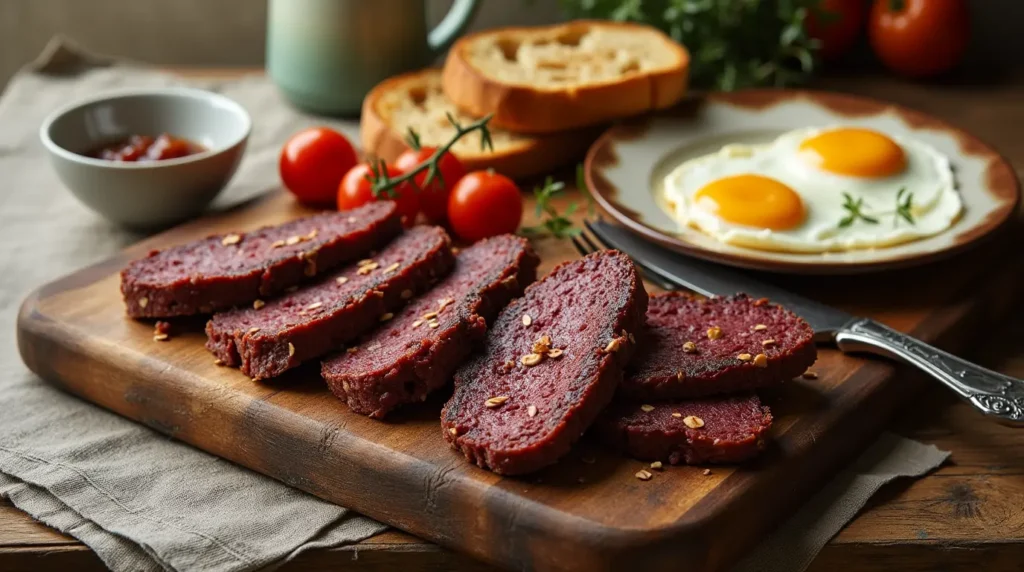When you think about traditional comfort food, what comes to mind? Perhaps a hearty stew or a warm loaf of bread. But for many, nothing stirs memory and meaning quite like blood pudding recipe. It’s more than just a meal—it’s a link to heritage, a taste passed down through generations.
Maybe you remember your grandparents preparing it during a holiday, or maybe you’ve only heard of it in stories. Either way, making blood pudding recipe from scratch offers you a deeper connection to culture, history, and the kind of homemade flavor you can’t get from a store.
In this article, you’ll learn how to make authentic blood pudding recipe step by step, with tips, insights, and expert guidance to help you recreate this timeless recipe in your own kitchen.
Table of Contents
ToggleWhat is Blood Pudding Recipe?
At its core, blood pudding recipe is a type of sausage made from animal blood (usually pig), mixed with a filler like oats or barley, fat, onions, and seasonings. Though it may sound unusual if you’re unfamiliar, it’s a beloved staple in many parts of the world.
A Global Tradition
- Ireland & UK: Known as “black pudding recipe” and often eaten with breakfast.
- Sweden & Finland: Served with lingonberry jam.
- Spain (Morcilla): Often cooked with rice and garlic.
- Philippines (Dinuguan): A blood-based stew variation.
Despite the differences in preparation, they all share one thing—blood pudding is a celebration of whole-animal cooking, a no-waste philosophy that’s deeply respected in culinary traditions.
Ingredients for an Authentic Blood Pudding Recipe
Getting the right ingredients is crucial. Here’s what you’ll need to create a traditional version that’s rich, flavorful, and true to its roots:
Blood Pudding Recipe Ingredients Table
| Ingredient | Amount | Notes |
|---|---|---|
| Fresh pig’s blood | 1 quart (4 cups) | Available from specialty butchers |
| Steel-cut oats | 1 cup | Traditional grain base |
| Pork fat or suet | 1 cup | Finely chopped |
| Onion (diced) | 1 medium | Adds depth and sweetness |
| Allspice | 1 teaspoon | Earthy warmth |
| Ground cloves | ½ teaspoon | Optional, adds punch |
| Salt & black pepper | To taste | Essential flavoring |
| Natural casings | As needed | Optional—can use loaf pan instead |
💡 Tip: If fresh blood isn’t available, many ethnic markets offer frozen options. Always ask your local butcher for help sourcing it.
Step-by-Step Guide: How to Make Blood Pudding Recipe from Scratch
You don’t need to be a chef to make blood pudding recipe—just a bit of patience and a willingness to explore traditional methods.
🧼 Step 1: Prepare Your Tools and Workspace
- Sanitize all utensils thoroughly.
- Soak oats in warm water for at least 30 minutes.
- If using sausage casings, rinse and soak them in warm water.
🥣 Step 2: Mix the Ingredients
- Combine the blood and oats in a large bowl.
- Add pork fat, chopped onion, and spices.
- Stir everything together slowly—do not whisk, as you want to avoid incorporating air.
- Season generously. It’s hard to adjust later once it’s cooked.
🧵 Step 3: Stuff or Pour
You have two main preparation options:
Option 1: Sausage-Style Pudding
- Use a sausage stuffer or funnel to carefully fill the casing.
- Don’t overpack; allow space for expansion.
- Tie off the ends securely with string.
Option 2: Loaf Pan Method
- Pour the mixture into a greased loaf tin.
- Cover with foil and prepare a water bath for gentle, even cooking.
🔥 Step 4: Cook Gently
- For sausages: Simmer in water at about 175°F (80°C) for 30–40 minutes. Avoid boiling—it’ll burst the casing.
- For loaf: Bake in a preheated oven at 350°F (175°C) for roughly 1 hour, until firm to the touch.
❄️ Step 5: Cool, Slice, and Stor
Once cooled:
- Slice into ½-inch pieces.
- Pan-fry until crispy for serving.
- Store in an airtight container in the fridge for up to 1 week, or freeze in slices for up to 3 months.
Expert Tips to Elevate Your Blood Pudding Recipe
💡 Flavor Boosters
- Add chopped garlic for more depth.
- A pinch of nutmeg or smoked paprika gives it warmth.
- Use homemade bone broth instead of water for soaking oats.
❌ Common Pitfalls
- Overcooking leads to a rubbery texture.
- Using raw onions without sautéing can overpower the flavor.
- Letting the blood sit too long before mixing causes it to coagulate—use it fresh.
How to Serve Blood Pudding Recipe Like a Pro
You’ve nailed the prep—now here’s how to turn it into a star dish on your table.
🍳 Traditional Pairings
- Irish Breakfast: Fried egg, beans, grilled tomato, hash browns, and toast.
- Scottish Style: Serve with tattie scones and haggis.
🌮 Modern Fusion Ideas
- Blood pudding tacos with pickled onions and aioli.
- Sliced and added to risotto or pasta for a rich umami bite.
- Served on crostini with caramelized apple slices.
Is Blood Pudding Recipe Healthy?
(Keyword: is blood pudding healthy)
You might be surprised—blood pudding recipe is packed with nutrients.
Nutritional Breakdown (per 100g)
| Nutrient | Amount |
|---|---|
| Calories | 379 kcal |
| Protein | 14g |
| Iron | 25% DV |
| Fat | 35g |
| Carbs | 8g |
| B12 & Zinc | High |
Blood pudding recipe is particularly good for people with iron deficiencies or those following high-protein diets. But, like any rich dish, it’s best enjoyed in moderation.
Final Thoughts: Your Heritage, One Bite at a Time
Cooking blood pudding recipe from scratch is more than a culinary task—it’s a journey into tradition. You’re not just making food; you’re reviving a recipe that once graced the tables of your ancestors. You’re cooking with intent, respect, and pride.
Don’t be afraid to experiment and adapt the recipe to your preferences. Whether you’re making it to honor family roots or simply to experience a new flavor profile, you’re adding your own story to a recipe that’s been passed down for centuries.
👩🍳 Ready to Make It?
Get your ingredients, follow the steps, and share your results. Post a photo on social media and tag @recipechefoliver—we’d love to feature your creation!
Blood pudding, also known as black pudding, is a traditional sausage made with animal blood (usually pork or beef), fat, oats, and spices. When cooked properly, it is entirely safe to eat and is a rich source of iron and protein.
Fresh blood can often be sourced from local butchers, ethnic markets, or farms. If unavailable, some specialty stores sell dried blood powder as a substitute.
Yes! While traditional blood pudding uses intestines as casings, you can bake it in a loaf pan or form it into patties for a casing-free version.
There are no reviews yet. Be the first one to write one.







